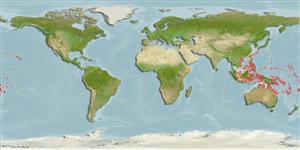>
Eupercaria/misc (Various families in series Eupercaria) >
Scaridae (Parrotfishes) > Scarinae
Etymology: Chlorurus: Greek, chloros = green + Greek oura = tail (Ref. 45335).
More on author: Bloch.
Environment: milieu / climate zone / depth range / distribution range
Ecologia
marinhas associadas(os) a recifes; intervalo de profundidade 0 - 20 m (Ref. 9710). Tropical; 30°N - 24°S, 102°E - 153°W
Pacific Ocean: Ryukyu Islands to Australia. Recently reported from Tonga (Ref. 53797).
Tamanho / Peso / Idade
Maturity: Lm ? range ? - ? cm
Max length : 56.2 cm FL macho/indeterminado; (Ref. 125599); peso máx. publicado: 2.2 kg (Ref. 125599)
Espinhos dorsais (total): 9; Raios dorsais (total): 10; Espinhos anais 3; Raios anais : 9. This species is further distinguished by having the following characters: median predorsal scales 4; scale rows on cheek 2; conical teeth absent on side of lower dental plate, 0-2 on upper plate of initial phase and often 2 on terminal male; lips slightly covers the dental plates; caudal fin in subadult slightly rounded to truncate and slightly emarginate in terminal male. Colour of male distinctly bicolored, with purple-brown anterior, and oblique division to pale yellow posterior; female entirely dark brown with red-orange tail (Ref. 9793, 90102).
Inhabits seaward coral (Ref. 58652) and rocky reefs (Ref. 9710); inner reefs with rich coral habitat (Ref. 48636). Feeds on benthic algae (Ref. 3488). May occur in small groups of 1 TP with 1 to 3 IPs (Ref. 9793). Caught mainly with traps, nets and other types of artisanal gear. Minimum depth reported taken from Ref. 128797.
Ciclo de vida ou comportamento de acasalamento
Maturidade | Reprodução | Desova | Ovos | Fecundidade | Larvas
Oviparous, distinct pairing during breeding (Ref. 205).
Randall, J.E. and J.H. Choat, 1980. Two new parrotfishes of the genus Scarus from the Central and South Pacific, with further examples of sexual dichromatism. Zool. J. Linn. Soc. 70:383-419. (Ref. 2689)
Status na Lista Vermelha da UICN (Ref. 130435)
Ameaça para os humanos
Harmless
Uso pelos humanos
Pescarias: espécies comerciais; Aquário: Espécies comerciais
Mais informação
ReferênciasAquaculturaPerfil para aquaculturaEstirpesGenéticaElectrophoresesHereditariedadeDoençasProcessamentoNutrientsConversão de massa
ColaboradoresFotosStamps, Coins Misc.SonsCiguateraVelocidadeTipo de nataçãoÁrea branquialOtólitosCérebrosVisão
Ferramentas
Relatórios especiais
Baixar XML
Fontes da internet
Estimates based on models
Preferred temperature (Ref.
123201): 25 - 29.3, mean 28.5 °C (based on 2061 cells).
Índice de diversidade filogenética (Ref.
82804): PD
50 = 0.5000 [Uniqueness, from 0.5 = low to 2.0 = high].
Bayesian length-weight: a=0.01259 (0.00710 - 0.02233), b=3.03 (2.88 - 3.18), in cm total length, based on LWR estimates for this species & (Sub)family-body (Ref.
93245).
Nível Trófico (Ref.
69278): 2.0 ±0.00 se; based on food items.
Resiliência (Ref.
120179): médio(a), tempo mínimo de duplicação da população 1,4 - 4,4 anos (Preliminary K or Fecundity.).
Fishing Vulnerability (Ref.
59153): Moderate vulnerability (45 of 100).
Nutrients (Ref.
124155): Calcium = 42.6 [17.5, 144.3] mg/100g; Iron = 0.666 [0.266, 1.657] mg/100g; Protein = 18.6 [16.6, 20.4] %; Omega3 = 0.0929 [, ] g/100g; Selenium = 31.3 [10.9, 94.3] μg/100g; VitaminA = 51.9 [16.1, 170.8] μg/100g; Zinc = 2.37 [1.06, 4.28] mg/100g (wet weight);
